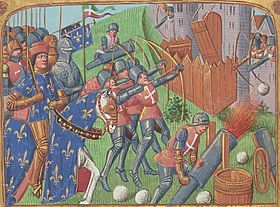Siege of Caen (1450) facts for kids
Quick facts for kids Siege of Caen |
|||||||
|---|---|---|---|---|---|---|---|
| Part of the Hundred Years' War | |||||||
 Siege of Caen, miniature from the Vigiles du roi Charles VII by Martial d'Auvergne, c. 1484 |
|||||||
|
|||||||
| Belligerents | |||||||
| Commanders and leaders | |||||||
The Siege of Caen was a major event in 1450 during the Hundred Years' War. This long conflict was mostly fought between the English and the French over who should rule certain lands, especially in France. During the siege, French forces surrounded the city of Caen in Normandy, which was controlled by the English at the time. This happened right after the French won a very important battle nearby.
Contents
What Was the Hundred Years' War?
The Hundred Years' War was a series of conflicts between England and France. It lasted for more than 100 years, from 1337 to 1453. The main reason for the war was that English kings claimed the throne of France. They also wanted to control rich lands in France, like Normandy.
- The war involved many battles and sieges.
- It changed how armies fought and how countries were ruled.
- By 1450, the war was nearing its end.
The Battle Before Caen
Before the Siege of Caen, a very important battle took place. This was the Battle of Formigny on April 15, 1450.
- At Formigny, the French army won a huge victory.
- They defeated a large English force.
- This win greatly weakened the English control over Normandy.
- Many English soldiers were killed or captured.
English Retreat to Caen
After their defeat at Formigny, the remaining English soldiers needed a safe place. Their commander, Edmund Beaufort, 2nd Duke of Somerset, led them to Caen.
- Caen was a strong city with good defenses.
- It was one of the last major English strongholds in Normandy.
- Somerset hoped to defend the city against the French.
The Siege Begins
The French army, led by Arthur de Richemont, quickly followed the English to Caen. They surrounded the city on June 5, 1450.
- The French army was much larger than the English forces inside Caen.
- They set up their siege equipment around the city walls.
- A siege means an army surrounds a city to cut off supplies.
- They try to force the people inside to surrender.
Fighting and Surrender
The siege lasted for about three weeks. The French attacked the city's defenses.
- The English inside Caen tried to hold out.
- But they were outnumbered and had been weakened by the previous battle.
- On July 1, 1450, Duke Edmund Beaufort surrendered Caen to the French.
- This was a big loss for the English.
What Happened Next?
The fall of Caen was a major turning point in the Hundred Years' War.
- It showed that English control over Normandy was almost over.
- After Caen, English power in the region quickly collapsed.
- The last English-held city in Normandy, Cherbourg, fell in August 1450.
- This meant that France had taken back almost all of Normandy.
End of English Rule in Normandy
The loss of Caen and other cities marked the end of a long period of English rule in Normandy.
- Normandy had been under English control for many years.
- This victory was a huge step towards France winning the Hundred Years' War.
- It helped to shape the borders of modern France.

